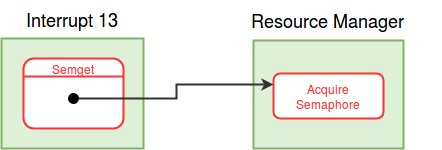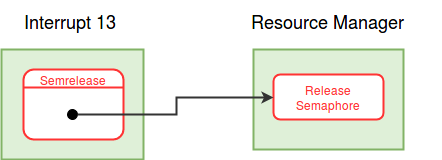Semget system call
Argument: None
Return Value :
| SEMID (Integer) | Success, returns a semaphore descriptor(SEMID) |
| -1 | Process has reached its limit of resources |
| -2 | Number of semaphores has reached its maximum |
Description: This system call is used to obtain a binary semaphore. eXpOS has a fixed number of semaphores. The semaphores of a process are shared with it's child processes. Data Structures updated are Per Process Resource Table and Semaphore table.
The mode flag in the Process Table has to be set to Kernel mode when the process enters the system call and must be reset before exiting from the system call.

Algorithm:
Set the MODE_FLAG in the Process Table to 17 and switch to kernel stack. Find the index of a free entry in the Per Process Resource Table. /* This will be our semaphore descriptor */ If no free entry, then return -1. Resource Identifier field of the per-process resource table entry is set to 1 to indicate that the resource is a semaphore. Acquire a semaphore by calling the acquire_semaphore() function in the Resource Manager Module. /* acquire_semaphore() module function acquires a semaphore by making an entry in the Semaphore Table and returns the index of the entry. If there are no free semaphores, it returns -1 */ If there are no free semaphores, return -2. Store the index of the Semaphore table entry in the Per Process Resource Table entry. /*Attach the semaphore to the process.*/ Switch back to the user stack by resoring the USER SP from the process table. Set the MODE_FLAG in the process table entry of the parent process to 0. Return the Per-process Resource Table entry index. /* Semaphore Descriptor */ Note: At each point of return from the system call, remember to reset the MODE FLAG and switch back to the user stack.
